|
Sunday:
September 2, 2001 | |
0401 GMT |
 |
Ulysses probe predicts weather at Sun's north pole
Space physicists predict gusty winds for the next few months at the Sun's north pole, an area that will be observed as the Ulysses spacecraft passes over it starting this weekend. This pass over the pole occurs at a time of solar maximum, when the Sun is more active.
 FULL STORY FULL STORY
 |  |

|
 |
Satellite views capture record Nile River flooding
Thousands of people in the Sudan lost their homes this year to the swollen waters of the Nile, which reached their highest levels in more than two decades. Four images from NASA's Terra satellite show the Nile and its main tributaries near Khartoum, before and after the rainy seasons in 2000 and 2001.
 FULL STORY FULL STORY
 |  |
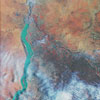
|
 |
|
Saturday:
September 1, 2001 | |
0022 GMT |
 |
Earth's light show is clue to finding habitable neighbors
Viewed from a star in some other corner of the galaxy, Earth would be a speck, a faint blue dot hidden in the blazing light of our sun. Would there be any hint of that speck's amazing diversity of life? According to new research, a savvy alien would find at least one important clue: an interesting flicker in the pale blue light.
 FULL STORY FULL STORY
 |  |

|
 |
Cluster 2 spacecraft surf the plasma waves
ESA's four Cluster spacecraft continue to provide ground-breaking new information about the interaction between our nearest star - the Sun - and planet Earth. As they sail through the sea of plasma that fills near-Earth space, the identical instruments on the Cluster quartet are helping scientists to create the first three-dimensional views of this turbulent region.
 FULL STORY FULL STORY
 |  |

|
 |
|
Friday:
August 31, 2001 | |
0323 GMT |
 |
First cells being grown in space station experiment
The first cell culture experiments aboard the International Space Station are on the way to being completed by early next week. The crew has been working with the 32 cell cultures that are growing kidney, ovarian and colon cells. This research is the first opportunity for scientists to begin growth of cell cultures that have never been exposed to Earth's gravity.
 FULL STORY FULL STORY
 |  |

|
 |
SIMBA hunts southern skies
A new instrument, called SIMBA, has been installed at the ESO La Silla Observatory. It is the first imaging millimetre instrument in the southern hemisphere, and opens exciting prospects for in-depth studies of the "hidden" sites of star formation, deep inside dense interstellar nebulae.
 FULL STORY FULL STORY
 |  |
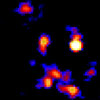
|
 |
|
Thursday:
August 30, 2001 | |
0930 GMT |
 |
Ariane 4 successfully launches Intelsat craft
An Arianespace Ariane 4 rocket was launched from South America today carrying the Intelsat 902 telecommunications satellite. It took about 21 minutes to inject the payload into geosynchronous transfer orbit around Earth, marking the 63rd consecutive successful launch of the workhorse Ariane 4.
 MISSION STATUS CENTER MISSION STATUS CENTER
 |  |

|
 |
Radiation-driven reactions on Jupiter's moons
By his own admission, Thomas Orlando deals with "weird chemistry." In fact, the Georgia Institute of Technology researcher studies chemical processes that are literally out of this world -- reactions occurring on the moons of Jupiter, driven by extreme radiation at ultra-cold temperatures.
 FULL STORY FULL STORY
 |  |

|
 |
Heavy metal stars
Very high abundances of the heavy element Lead have been discovered in three distant stars in the Milky Way Galaxy. This finding strongly supports the long-held view that roughly half of the stable elements heavier than Iron are produced in common stars during a phase towards the end of their life when they burn their Helium.
 FULL STORY FULL STORY
 |  |
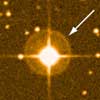
|
 |
|
Wednesday:
August 29, 2001 | |
0815 GMT |
 |
Japan's H-2A rocket launches on maiden flight
The Japanese space agency's H-2A rocket was launched on its crucial inaugural flight today carrying a simulated satellite payload bound for a geosynchronous transfer orbit around Earth. Check the status center for updates.
 MISSION STATUS CENTER MISSION STATUS CENTER
 |  |
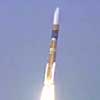
|
 |
Ariane 4 rocket set for predawn liftoff Thursday
Six weeks after its next-generation Ariane 5 rocket malfunctioned, Arianespace is ready for its next commercial satellite launch, albeit using the older workhorse Ariane 4 booster. Officials have cleared the Ariane 4 for blastoff early Thursday carrying the Intelsat 902 satellite.
 FULL STORY FULL STORY
 |  |
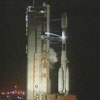
|
 |
NOAO: The 'big one' that almost got away
Astronomers have discovered a double star system, known as a massive X-ray binary, with an orbit so elongated that the twosome appears to have barely survived the disruptive effects of the supernova that transformed them into a fountain of X-ray energy.
 FULL STORY FULL STORY
 |  |
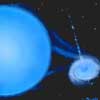
|
 |
Astronomers discover six-image gravitational lens
An international team of astronomers has found the first gravitational lens in which the single image of a very distant galaxy has been split into six different images. The unique configuration is produced by the gravitational effect of three galaxies along the line of sight between the more-distant galaxy and Earth.
 FULL STORY FULL STORY
 |  |

|
 |
|
Tuesday:
August 28, 2001 | |
0218 GMT |
 |
Countdown ticking for Japan's maiden H-2A launch
Final preparations are underway for perhaps the most important launch in
Japanese space history -- the inaugural flight of the H-2A rocket. Liftoff is slated for 0400 GMT (12 a.m. EDT) Wednesday from Tanegashima, Japan.
 FULL STORY FULL STORY
 |  |

|
 |
European probes to identify underground water on Mars
Geologists poring over the latest images from Mars keep on turning up new and tantalising evidence that water once flowed freely on the planet's surface - and may still flow from time to time. Underground aquifers or ice layers could be commonplace, but no spacecraft flown so far has been capable of identifying them.
 FULL STORY FULL STORY
 |  |
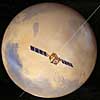
|
 |
TRMM satellite boosted to extend global climate watch
NASA recently completed a set of maneuvers on the Tropical Rainfall
Measuring Mission (TRMM) spacecraft to boost its orbit around Earth. The
push into a higher orbit will prolong the satellite's life and continue
to provide meteorologists and climatologists data to forecast and better
understand global climate change.
 FULL STORY FULL STORY
 |  |

|
 |
DAILY BRIEFING Other stories making news today
|
 |
Routine chores on tap this week aboard Galileo -- This is a relatively busy week for Galileo with an instrument calibration, tape recorder maintenance, an orbit trim maneuver, propulsion system activities and Io flyby data playback all on the agenda.
|
 |
|
Monday:
August 27, 2001 | |
0304 GMT |
 |
Boeing's Delta 4 test rocket rolled to Cape launch pad
For the first time a rocket is sitting atop Boeing's launch pad for the new millennium at Cape Canaveral as activities continue for the maiden flight of the Delta 4 next spring.
 FULL STORY FULL STORY
 |  |

|
 |
Libyan dust storm seen by orbiting satellite
This image from NASA's SeaWiFS instrument aboard a commercial OrbImage satellite captured last week shows a significant dust storm originating in Libya and blowing out across the Mediterranean Sea.
 FULL STORY FULL STORY
 |  |

|
 |


 The Hubble Space Telescope's majestic view of the Eskimo Nebula. This spectacular poster is available now from the Astronomy Now Store.
The Hubble Space Telescope's majestic view of the Eskimo Nebula. This spectacular poster is available now from the Astronomy Now Store.